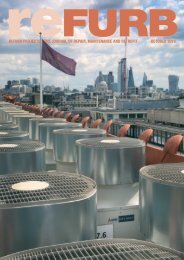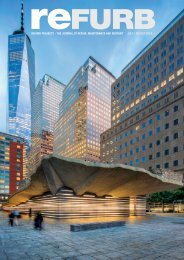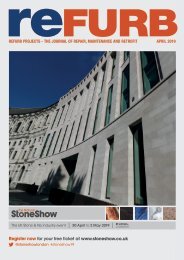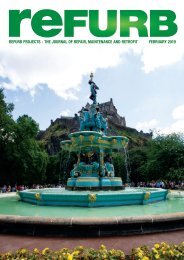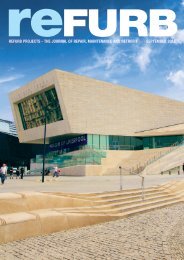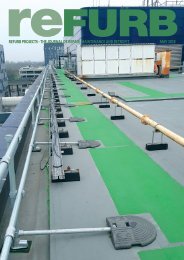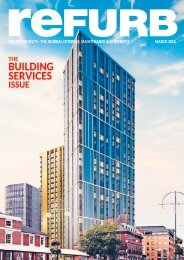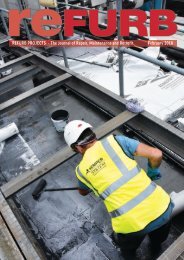Refurb Projects - November 2018
Refurb Projects launched in 1987 to cater for the expanding Repair, Maintenance, Improvement and Refurb sectors of the UK Building Industry. This represents a massive market, with refurbishment in the Health, Leisure, Education and Social Housing sectors expecting to be the mainstay of the industry for the foreseeable future. Sustainability and the protection of the built environment are essential ingredients of the refurbishment market, and Refurb Projects Journal is a leader in reporting and promoting these ideals.
Refurb Projects launched in 1987 to cater for the expanding Repair, Maintenance, Improvement and Refurb sectors of the UK Building Industry. This represents a massive market, with refurbishment in the Health, Leisure, Education and Social Housing sectors expecting to be the mainstay of the industry for the foreseeable future. Sustainability and the protection of the built environment are essential ingredients of the refurbishment market, and Refurb Projects Journal is a leader in reporting and promoting these ideals.
Create successful ePaper yourself
Turn your PDF publications into a flip-book with our unique Google optimized e-Paper software.
PROJECTS<br />
Restoration of Grade II* listed mill using<br />
£554k Heritage Lottery Fund money begins<br />
People will be able to visit the<br />
restored Stracey Arms Mill<br />
near Great Yarmouth thanks<br />
to Norfolk County Council’s<br />
successful bid for £554,600 from the<br />
Heritage Lottery Fund (HLF).<br />
Works have begun to safeguard<br />
the mill and create a building onsite<br />
for people to learn about the history<br />
of the mill and the surrounding<br />
marshland. A programme of<br />
workshops, day schools and<br />
community events will begin in 2019<br />
for people to learn more about the<br />
mill, the local landscape, and the<br />
marsh families who lived at the mill<br />
site and worked on the surrounding<br />
marshes.<br />
A number of volunteer<br />
opportunities, with full training, will<br />
also be available for people<br />
interested in looking after the mill.<br />
Visitors will be able to make use of a<br />
10 space car park to the east of the<br />
mill which will itself be made more<br />
accessible with the aid of an all<br />
ability access ramp from the car<br />
park to the mill. Work is expected to<br />
be completed in 2021.<br />
Councillor Martin Wilby,<br />
Chairman of Norfolk County<br />
Council’s Environment,<br />
Development and Transport<br />
Committee and Chairman of the<br />
Norfolk Windmills Trust, said: “This<br />
is a fantastic project that will allow<br />
people to better understand the<br />
history of Norfolk and its historic<br />
marshes and distinctive Broads, and<br />
I’m pleased it was made possible by<br />
our bid to the Heritage Lottery<br />
Fund.”<br />
“Thanks to National Lottery<br />
players, work is now well underway.<br />
This is an exciting moment in the<br />
restoration of such an important<br />
building from Norfolk’s agricultural<br />
past and the start of a great new<br />
future” said Robyn Llewellyn, Head<br />
of HLF East England.<br />
The works to the Grade II* listed<br />
mill, part of the £670,152 Mill and<br />
Marsh Folk Project, have begun with<br />
the removal of the old cap and sail<br />
stocks which have been taken to the<br />
millwright’s workshop to be assessed<br />
and any sound timbers salvaged and<br />
reused in the new cap.<br />
The first phase of work, which<br />
includes brickwork repairs, removal<br />
of internal render, reinstatement of<br />
one of the Second World War gun<br />
loops and repairs to windows and<br />
doors, is being led by conservation<br />
builders R & J Hogg Ltd of Coney<br />
Weston. The millwrighting work<br />
which also includes new stocks, sails<br />
and repairs to the turbine pump is<br />
being carried out by local millwright<br />
Richard Seago.<br />
Smithdales the Acle millwrights. In<br />
1965, Stracey Arms Mill was the<br />
second mill to be gifted to Norfolk<br />
County Council, to be cared for by<br />
the newly formed Norfolk Windmills<br />
Trust, by the widow of Sir Edward<br />
Paulet Stracey, 7th Baronet Stracey<br />
of Rackheath Hall.<br />
Tel: 01603 228888<br />
Email: pressoffice@norfolk.gov.uk<br />
BACKGROUND HISTORY<br />
The mill was built for Sir Henry<br />
Stracey of Rackheath Hall by<br />
millwright and engineer Richard<br />
Barnes of Southtown Ironworks in<br />
1883, at the height of mill<br />
technology. The mill replaced an<br />
earlier mill on the site and was built<br />
to drain water off the surrounding<br />
marshes into the River Bure. The mill<br />
was last used to drain the marshes<br />
in the 1940s. The mill served as a<br />
fortified pillbox during the Second<br />
World War with gun loops cut into<br />
the tower, as part of the defences of<br />
the local area. The mill gradually fell<br />
into disrepair. Major repairs were<br />
carried out in the 1960s by<br />
REFURBISHMENT PROJECTS, NOVEMBER <strong>2018</strong> 25







